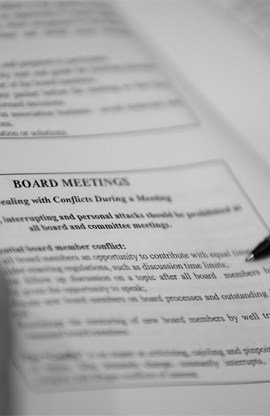By Beth Mulcahy, Esq.
Board meetings are typically not well attended. Everyone is busy, so the association board meeting is often low on the “to-do-list” because it takes too much time. Don’t let the long drawn-out board meeting filled with trivia be the reason your association members do not attend. Making your board meeting an efficient business meeting in an hour or less may mean your members will feel that they can attend. The key to a successful board meeting is a clear agenda with specific items for action and discussion.
I suggest the following agenda to get your board meeting going and keep it on track.
1. Call to Order– the board president calls the meeting to order at the time specified in the meeting notice. By starting the board meeting on time, at the posted time, members are shown that this is a professional business meeting. Consistently starting on time will help encourage members to arrive on time.
2. Establish a Quorum– a quorum is established by the president. He/she calls roll of the board members and a count is taken to determine if a majority is present.
3. Approval of Minutes-The minutes of the last meeting should be included in the board packet given to board members prior to the board meeting. This allows directors to review the minutes and determine if corrections are necessary prior to the vote to approve the minutes.
4. Financial Report-The treasurer should be well versed with the financial report so that he/she can present and explain the financial status of the association. The financial report is a summary of available cash, unanticipated expenses, and it should include a comparison of the current finances with the approved annual budget.
5. Manager’s Report– The manager’s report should be included in the board packet and presented to the board several days in advance of the meeting. The manager’s report should detail what has taken place in the association from the last meeting, and include any matters that need to be approved by the board. It is wise to concentrate discussion on the items that need board approval.
6. Committee Reports-Not all committees will provide reports. Those that do should include them in the board packet allowing directors an opportunity to familiarize themselves with the work of the committee to determine if board action is required.
7. Old Business– Items discussed in a previous meeting that required further research or discussion before action by the board are addressed again in the old business.
8. New Business-New items for future consideration are presented. Directors can help with the efficiency of the meeting if they submit any new business with any back up information prior to the meeting to be included in the board packet.
9. Adjournment-this closes the meeting. The time of adjournment can be posted in the meeting notice which provides certainty of a meeting’s end. A specific adjournment time also encourages focus on the agenda items. Before adjourning, the board should announce the meeting time of the next meeting.
The Public Forum-The public form allows time for association members in attendance to express comments or complaints to the board of directors. This is typically done prior to the opening of the business meeting. Holding it prior to the meeting allows members to come and be heard and then leave if they are otherwise busy. Often boards limit the time allotted each member who wishes to speak. Members should be given an outline of presentation procedures prior to opening the forum. The board will not act upon issues during the forum; however the wise board will see that the questions addressed to the board are researched and answered. If the same issue arises several times in a forum the board should consider addressing that issue at the next meeting as a specific agenda item.
Organization, planning and following the agenda are the foundation of the effective board meeting. The president should have a working knowledge of Robert’s Rules of order because he is responsible for moving the meeting along. Board members are responsible for coming to the meeting informed, having read their board packets and ready to be an active member of all discussions.
Good Luck!
